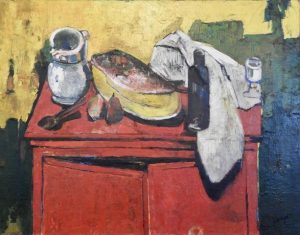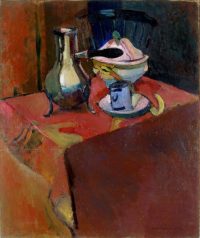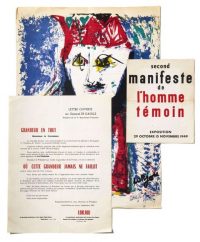By Rachel Vincent-Clarke, Communications and Collections Assistant, McGill Visual Arts Collection

Figure 1 Bernard Lorjou (1908-1986), Le Buffet Rouge (1946-47), oil on canvas, 113 x 144 cm. Gift of Hélène V. Rubin and Lionel Rubin, B.C.L. ’35, conserved with the support of a generous donor. McGill Visual Arts Collection. © Association Bernard Lorjou
In a room on the main floor of Birks building, the home of the School of Religious Studies, hangs a vibrant still life painting by French expressionist artist Bernard Lorjou (1908-1986). Le Buffet Rouge (Fig. 1), dated 1946-47, depicts an array of victuals and tableware loosely displayed on a bright crimson dresser – a grey water jug, a wooden spoon, two pears, a carp on a yellow porcelain plate, an opened bottle of wine, an empty wine glass, and a crumpled white tablecloth. These objects, juxtaposed over a rich blue, green and yellow background, are rendered prominent as a result of the seemingly deliberate absence of perspective in the work. The aesthetic appeal of Le Buffet Rouge is largely attributable to the flatness and colourfulness of its composition, but also to the curiously generous application of paint onto the canvas.
About Bernard Lorjou
Better known in his native France than in Canada, Bernard Lorjou had an unusual upbringing. Born in Loire et Cher in 1908, on the advent of the First World War, he spent the first 13 years of his life in a significantly impoverished family before leaving for Paris to follow his already formed aspiration: to become a successful painter.[1] His early years in the City of Lights proved to be particularly arduous. Eventually, though, he was hired as a draughtsman for a prestigious silk house led by businessman and artist François Duharne.[2] There, he met his future wife Yvonne Mottet, a fellow artist and painter, and found tremendous success as a silk designer. His designs adorned the silhouettes of some of the world’s most prominent women and brought him enough of a comfortable income that he was eventually able to paint on a full-time basis. [3]

Figure 2 Henri Matisse (1869-1954), Crockery on a Table (1900), oil on canvas, 97 x 82 cm., State Hermitage Museum, Saint Petersburg, Russia.
Lorjou’s first exhibition of paintings took place in 1928 at the Salon des Indépendants in Paris. Already, his works demonstrated great freedom, both in terms of graphic expression and the handling of colours. While the influence of Courbet, Velasquez, and Goya appeared in his early paintings, as a result of his multiple travels to Spain, his chromatic audacity and choice of subjects brought a unique character to his work.[4] Not unlike Henri Matisse, whom he also evidently admired and emulated (Fig. 2), Bernard Lorjou progressively established himself as a master of the expressive language of colour and drawing. His brush strokes bore the mark of a sensible and impulsive man who fiercely refused to conform with the aesthetic norms that dominated the constrained artistic milieu that constituted the School of Paris painters.[5] His paintings were notably exhibited in France, Japan, and the United-States.

Figure 3 Catalogue, poster, and open letter by Bernard Lorjou, one of the founding members of L’Homme témoin.
A founding member of the group of young French painters l’Homme témoin, which fought to preserve figurative painting amidst the growing trend of abstraction of the first half of the twentieth century, Lorjou gained international recognition for the eccentric and fiery nature that translated into his work as well as for his combative spirit (Fig. 3).[6] Indeed, his political advocacy was just as loud as his artistic production. Passionate about social justice, he was heavily involved in debates surrounding colonialism, racial segregation, poverty in France and various health diseases. With a final show in 1985, the year before his passing, he denounced the risk of an AIDS epidemic.[7] In art as in life, Lorjou had strong convictions, very high regard for his practice, and very little concern for his detractors.[8]
Le Buffet Rouge and its history at McGill
A gift of Hélène V. Rubin and alumni Lionel Rubin, who obtained three degrees from McGill – a Bachelor of Arts in 1930, a Masters of Arts in Economics and Political Science in 1931, and a Bachelor of Common Law in 1935 –, the painting came to the University in 1977 as “but a small token of [their] gratitude to McGill for its immeasurable contribution to our community and country”.
Le Buffet Rouge was initially installed, quite fittingly with its title, in the dining salon of the Faculty Club. There, it witnessed countless dinners, banquets and special events, along with the inevitable animated discussions that come with such reunions. One can’t help but think Lorjou would have enjoyed these exchanges.
Among the many people who encountered the painting was, in 1986, a renowned art conservator by the name of Robin Ashton. He, like most viewers, was struck by the vividness of the work and intrigued by the strangely thick application of the paint onto the canvas. After contacting the Visual Arts Collection and conducting a meticulous examination of it, he established “that the work was painted on top of another painting which was probably a vertical composition”. This conclusion was based on the facts that the very thick patches of paint were often inconsistent with the general composition of the work and that different colours showed through the paint from underneath. The artist must have slathered layers and layers of paint in an attempt to eliminate all traces of the hues of his initial realisation. This is quite understandable as part of Lorjou’s trademark was the crispness of his colours.

Figure 4 View of the Painting in the Common Room of Birks Building, 2019. Photo Credit: McGill Visual Arts Collection
Inevitably, the moment came where the work’s integrity was jeopardized due to buckling, as a result of the heavy paint. The preservation of the painting required conservation, for fear that it would become no longer exhibitable. The crucial process of restoring Le Buffet Rouge involved a lengthy stretching and relining and could not have been possible without the support of a generous donor who, in 2015, offered to cover the costs of the treatment.
Following a careful conservation treatment by Legris Conservation, Le Buffet Rouge was returned to the Birks Common Room as the pièce de résistance, where it can still be admired today in all of its intriguing and colourful glory (Fig. 4).
[1] Shibanuma, Junko. Biographie de Bernard Lorjou. Association Bernard Lorjou, 2019. Retrieved from : http://lorjou.com/?p=104#more-104
[2] Boucher, Jean-Jacques. Arts et techniques de la soie. Fernand Lanore, 1996. p.69
[3] Gérard, Georges, and Bernard Lorjou. Lorjou, le peintre du siècle. Publisud, 1989.
[4] Bouhanna, Alain. Lorjou : le rebelle. Association Bernard Lorjou, 2018. Retrieved from: http://lorjou.com/?p=267
[5] Ibid
[6] Chilvers, Ian & Glaves-Smith, John. A dictionary of Modern and Contemporary Art (2ed.). Oxford University Press, 2019. Retrieved from: https://www.oxfordreference.com/view/10.1093/acref/9780199239665.001.0001/acref-9780199239665-e-1219
[7] Ibid
[8] A wealth of information on Lorjou can be found at http://lorjou.com, the official website of Association Bernard Lorjou.














Leave a Reply
You must be logged in to post a comment.